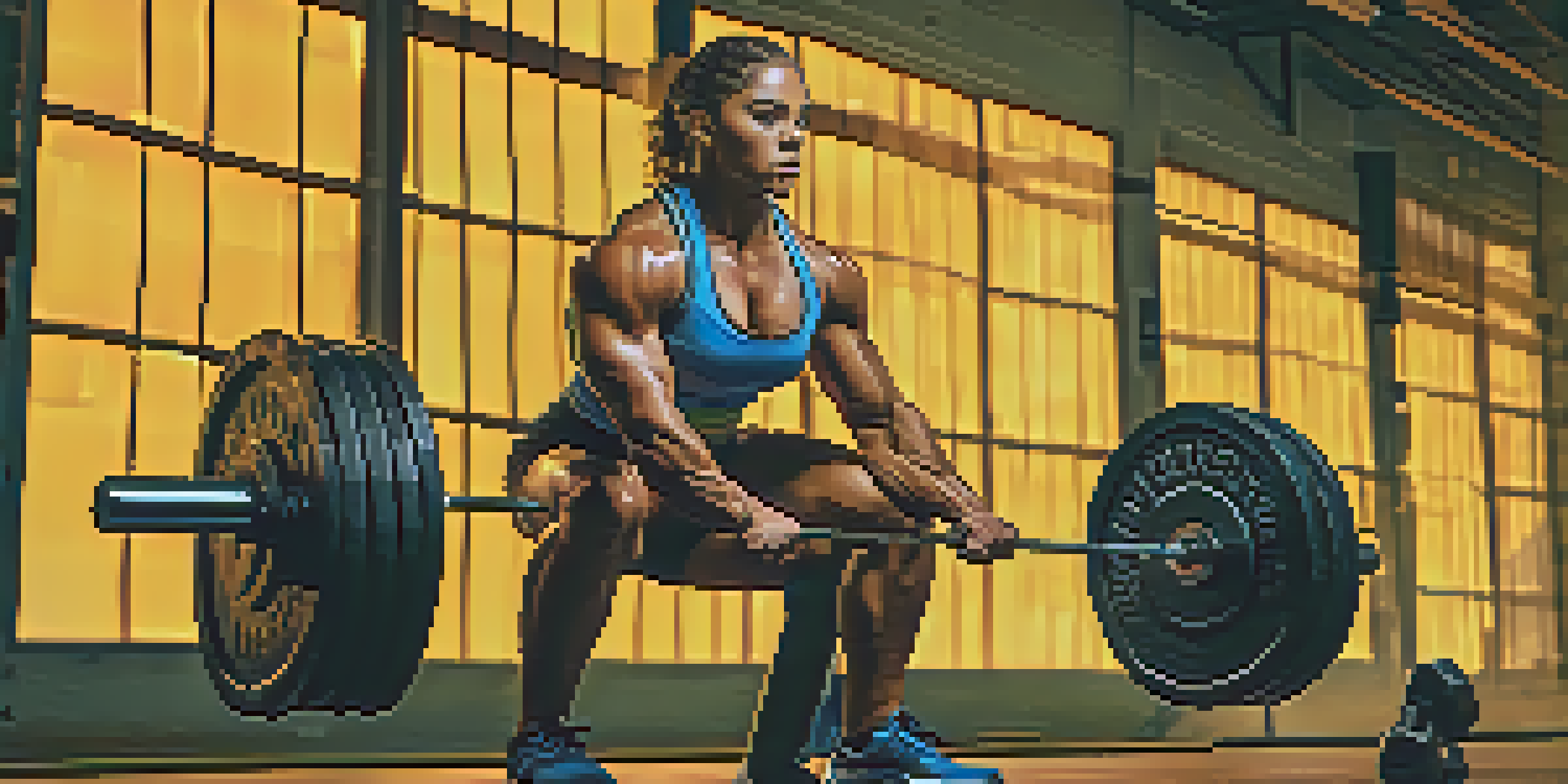Strengthening the Core: Cross-Training for Powerlifting

Understanding the Importance of Core Strength in Powerlifting
Core strength is the foundation of effective powerlifting. It involves the muscles in your abdomen, lower back, hips, and pelvis, which work together to stabilize your body during lifts. A strong core contributes not only to better performance but also to injury prevention, allowing lifters to push their limits safely.
Strength does not come from physical capacity. It comes from an indomitable will.
When performing lifts like squats, deadlifts, and bench presses, your core acts like a bridge, transferring energy between your upper and lower body. If your core is weak, your lifting form can suffer, leading to poor results and potential injuries. Strengthening your core should be a priority for anyone serious about powerlifting.
Incorporating core training into your routine enhances your overall stability, balance, and strength. Just like a solid foundation is essential for a sturdy building, a strong core supports every movement in powerlifting. This understanding lays the groundwork for effective cross-training strategies.
Cross-Training: A Holistic Approach to Strength Building
Cross-training involves incorporating various forms of exercise into your routine to enhance overall fitness. For powerlifters, this means engaging in activities that complement and strengthen the muscles used during lifting. It not only boosts performance but helps to break the monotony of a strict powerlifting regimen.

Activities like swimming, cycling, or even yoga can improve cardiovascular endurance, flexibility, and core strength. For example, swimming works the core while also providing a low-impact workout that can aid recovery. By diversifying your workouts, you can build a well-rounded foundation that supports your powerlifting goals.
Core Strength is Essential for Lifts
A strong core stabilizes the body during powerlifting, improving performance and reducing injury risk.
Engaging in cross-training reduces the risk of overuse injuries, as it allows different muscle groups to recover while still maintaining fitness levels. When you mix things up, you keep your body guessing, which can lead to better gains in strength and performance. This holistic approach is key to long-term success in powerlifting.
Core-Specific Exercises to Enhance Powerlifting Performance
To effectively strengthen your core, focus on exercises that target various muscle groups. Planks, for instance, engage multiple areas of your core and improve stability. Variations like side planks and plank with arm lifts can also challenge and enhance your overall strength.
The difference between a successful person and others is not a lack of strength, not a lack of knowledge, but rather a lack in will.
Another excellent choice is the dead bug exercise, which promotes core stability while mimicking the coordination required in powerlifting. This exercise helps you learn to control your core while moving limbs, which is crucial during heavy lifts. Keeping core strength engaged translates directly to improved lifting performance.
Lastly, implement medicine ball exercises like Russian twists or slams, which can enhance explosive core strength. These dynamic movements mimic the need for power and stability during lifts, making them a perfect addition to your routine. By integrating these core-specific exercises, you’ll pave the way for enhanced powerlifting results.
Incorporating Mobility Work for Better Lifting Mechanics
Mobility work is essential for any powerlifter aiming to improve their lifting mechanics. It involves exercises that enhance the range of motion in your joints, which can lead to better lifting form and decreased injury risk. Think of mobility work as lubrication for your joints, making every movement smoother and more effective.
Dynamic stretches and mobility drills should be included in your warm-ups to prepare your body for lifting. Exercises like hip openers and thoracic spine rotations can improve flexibility and help you reach optimal positions during lifts. This preparation not only makes lifting easier but can also help you lift heavier weights with better form.
Nutrition Fuels Strength Development
Balanced nutrition supports muscle growth and recovery, which is crucial for enhancing core strength in powerlifting.
Incorporating mobility work into your routine is like fine-tuning an engine; it allows all parts to work together efficiently. When your body moves freely, your core can engage better, supporting your lifts. Thus, a commitment to mobility can dramatically enhance your powerlifting performance.
The Role of Nutrition in Core Strength Development
Nutrition plays a critical role in building core strength and overall lifting performance. Consuming a balanced diet rich in protein, healthy fats, and carbohydrates fuels your workouts and aids recovery. Think of your body as a machine; without the right fuel, it won’t run efficiently, especially during demanding powerlifting sessions.
Hydration is equally important as it supports muscle function and recovery. Dehydration can lead to decreased performance and increased risk of injury, so drinking enough water throughout the day is essential. Incorporate foods that promote muscle repair and growth, such as lean meats, eggs, nuts, and leafy greens, to bolster your core strength.
By paying attention to your nutrition, you ensure your body has the necessary resources to build strength effectively. Just like a strong core supports your lifts, a well-fueled body supports a strong core. This synergy between nutrition and strength training can lead to impressive powerlifting results.
Balancing Training and Recovery for Optimal Results
Finding the right balance between training and recovery is crucial for powerlifters. Overtraining can lead to fatigue and injuries, while insufficient recovery can hinder muscle growth and performance. Think of your training like a seesaw; both sides need to be balanced for optimal function.
Incorporating rest days and active recovery techniques, like light stretching or foam rolling, can significantly enhance your performance. This allows your muscles time to repair and grow stronger, making you more resilient during lifts. Listening to your body and adjusting your routine accordingly is key to ensuring long-term success.
Recovery Balances Training Success
Adequate recovery and rest are vital for muscle repair and performance, ensuring long-term success in powerlifting.
Remember, recovery isn’t just about physical rest; it also involves mental downtime. Engaging in activities you enjoy outside of lifting can help refresh your mind and maintain motivation. By prioritizing both training and recovery, you set yourself up for a more successful powerlifting journey.
Tracking Progress and Adjusting Your Cross-Training Plan
Tracking your progress is vital for understanding what works and what needs adjustment in your cross-training plan. Keeping a journal or using apps can help you monitor your workouts, core exercises, and overall performance. This data allows you to see trends, celebrate milestones, and identify areas for improvement.
Regularly evaluating your progress also helps you stay motivated and focused on your goals. If you notice a plateau in your powerlifting performance, it may be time to tweak your cross-training routine. Remember, flexibility in your training approach is essential for continuous growth and improvement.

As you advance in your powerlifting journey, don’t hesitate to experiment with new exercises or training techniques. Incorporating feedback from your body and adjusting your plan accordingly will keep your workouts fresh and effective. This proactive approach ensures that you’re always moving toward your powerlifting aspirations.